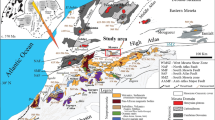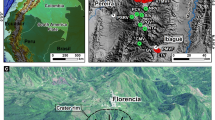Abstract
The Tiribí Tuff covered much of the Valle Central of Costa Rica, currently the most densely populated area in the country (∼2.4 million inhabitants). Underlying the tuff, there is a related well-sorted pumice deposit, the Tibás Pumice Layer. Based on macroscopic characteristics of the rocks, we distinguish two main facies in the Tiribí Tuff in correlation to the differences in welding, devitrification, grain size, and abundance of pumice and lithic fragments. The Valle Central facies consists of an ignimbritic plateau of non-welded to welded deposits within the Valle Central basin and the Orotina facies is a gray to light-bluish gray, densely to partially welded rock, with yellowish and black pumice fragments cropping out mainly at the Grande de Tárcoles River Gorge and Orotina plain. This high-aspect ratio ignimbrite (1:920 or 1.1×10−3) covered an area of at least 820 km2 with a long runout of 80 km and a minimum volume outflow of 25 km3 (15 km3 DRE). Geochemically, the tuff shows a wide range of compositions from basaltic-andesites to rhyolites, but trachyandesites are predominant. Replicate new 40Ar/39Ar age determinations indicate that widespread exposures of this tuff represent a single ignimbrite that was erupted 322±2 ka. The inferred source is the Barva Caldera, as interpreted from isopach and isopleth maps, contours of the ignimbrite top and geochemical correlation (∼10 km in diameter). The Tiribí Tuff caldera-forming eruption is interpreted as having evolved from a plinian eruption, during which the widespread basal pumice fall was deposited, followed by fountaining pyroclastic flows. In the SW part of the Valle Central, the ignimbrite flowed into a narrow canyon, which might have acted as a pseudo-barrier, reflecting the flow back towards the source and thus thickening the deposits that were filling the Valle Central depression. The variable welding patterns are interpreted to be a result of the lithostatic load and the influence of the content and size of lithic fragments.













Similar content being viewed by others
References
Alfaro A (1913) Rocas volcánicas de Costa Rica. Boletín de Fomento 8:549–555
Alvarado GE (1990) Características geológicas de la estación biológica La Selva, Costa Rica. Tecnología en marcha 10(3):11–22
Alvarado GE, Kussmaul S, Chiesa S, Gillot PY, Appel H, Wörner G, Rundle C (1992) Resumen chronoestratigráfico de las rocas ígneas de Costa Rica basado en dataciones radiométricas. J Earth Sci South Am 6(3):151–168
Appel H (1990) Geochemie und K/Ar-Datierung on Magmatiten in Costa Rica, Zentralamerika. PhD Thesis, Johannes Gutenberg Universität, Mainz, pp 1–149
Beget JE, Limke AJ (1989) Density and void ratio on emplacement of a small volume pyroclastic flow. J Volcanol Geotherm Res 39:349–353
Bellon H, Tournon J (1978) Contribution de la geochronologie K/Ar a l´étude du magmatisme de Costa Rica, Amerique Centrale. Bull Soc Geol France 20(6):955–959
Bergoeing JP (1982) Dataciones radiométricas en algunas muestras de Costa Rica. Instituto Geográfico Nacional Informe Semestral enero–diciembre 28:71–86
Berrangé J, Mathers S, Morales N, Alvarado F (1990) The non-metallic industrial minerals and rocks of Costa Rica. Proyecto Anglo-Costarricense de Minerales Industriales PACOMI, British Geological Survey BGS, Dirección de Geología y Minas DGM, Refinadora Costarricense de Petróleo RECOPE, San José, Costa Rica, pp 1–230
Borgia A, Burr J, Montero W, Morales LD, Alvarado GE (1990) Fault propagation folds induced by gravitational failure and slumping of the Central Costa Rica volcanic range: implications for large terrestrial and Martian volcanic edifices. J Geophys Res 95:14357–14382
Cole PD, Guest JE, Duncan AM (1993) The emplacement of intermediate volume ignimbrites: a case study from Roccamonfina volcano, southern Italy. Bull Volcanol 55:467–480
Dengo G (1961) Notas sobre la geología de la parte central del litoral Pacífico de Costa Rica. Instituto Geográfico Nacional Informe Semestral julio–diciembre 2:43–63
Dengo G, Chaverri G (1951) Reseña geológica de la región sudoeste de la Meseta Central de Costa Rica. Rev Univ Costa Rica 5:313–326
Denyer P, Arias O (1991) Estratigrafía de la región central de Costa Rica. Rev Geól Amér Central 12:39–41
Duffield WA, Dalrymple GB (1990) The Taylor Creek Rhyolite of New Mexico: a rapidly emplaced field of domes and lava flows. Bull Volcanol 52:475–478
Echandi E (1981) Unidades volcánicas de la vertiente norte de la cuenca del Río virilla. PhD Thesis, Universidad de Costa Rica, San José, pp 1–123
Eichelberger JC, Koch FG (1979) Lithic fragments in the Bandelier Tuff, Jemez Mountains, New Mexico. J Volcanol Geotherm Res 5:34–115
Erismann TH, Abele G (2001) Dynamics of rockslides and rockfalls. Springer, Berlin Heidelberg New York, pp 1–316
Fernández M (1968) Las unidades hidrogeológicas y los manantiales de la vertiente norte de la cuenca del Río Virilla. Informe Técnico Ministerio Agricultura Ganadería 27:1–44
Fisher RV (1979) Models from pyroclastic surges and pyroclastic flows. J Volcanol Geotherm Res 6:305–318
Gans P, Alvarado GE, Pérez W, MacMillan I, Calvert A (2003) Neogene evolution of the Costa Rican arc and development of the Cordillera Central. Geol Soc Amer Abstr Progr 31:A479
Gradstein FM, Ogg JG, Smith AG, Bleeker W, Lourens LJ (2004) A new geologic time scale, with special reference to Precambrian and Neogene. Episodes 27(2):83–100
Hannah RS (2000) Chemical variation in the 0.33 Ma Valle Central Tuff (Costa Rica): poligenetic origin of low to high silica magmas in a mature island arc environment. MSc Thesis, Michigan State University, East Lansing, MI, pp 1–102
Hannah RS, Vogel AT, Patino LC, Alvarado GE, Perez W, Smith DR (2002) Origin of silicic volcanic rocks in Central Costa Rica: a study of a chemically variable ash-flow sheet in the Tiribí Tuff. Bull Volcanol 64:117–133
Hoblitt RP (1986) Observations of the eruptions of July 22 and August 7, 1980 at Mt. St. Helens, Washington. USGS Prof Paper 1335, USGS, Boulder, CO
Kussmaul S (1988) Comparación petrológica entre el piso volcánico del Valle Central y la Cordillera Central de Costa Rica. Rev Cienc Tec 12(1–2):109–116
Kussmaul S, Sprechmann P (1982) Estratigrafía de Costa Rica (América Central), II: Unidades estratigráficas ígneas. V Congreso Latinoamericano de Geología, Buenos Aires Argentina Acta I:73–79
Kussmaul S, Paniagua S, Gaínza J (1982) Recopilación, clasificación e interpretación petroquímica de las rocas ígneas de Costa Rica. Instituto Geográfico Nacional Informe Semestral julio–diciembre 28:17–79
Ledbetter MT (1985) Tephrochronology of marine tephra adjacent to Central America. Geol Soc Am Bull 96:77–82
Le Maitre RW et al (1989) A classification of igneous rocks and glossary of terms: recommendations of the International Union of Geological Sciences Subcommission on the Systematics of Igneous Rocks. Blackwell, Oxford, pp 1-193
Madrigal R (1967) Estudio geológico y evaluación de algunos yacimientos de piedra pómez en Costa Rica. Informe Departamento Geología Minería Petróleo 26:1–29
Madrigal R (1970) Geología del mapa básico Barranca, Costa Rica. Informe Técnico Notas Geológicas 37
Malavassi E (1991) Magma sources and crustal processes at the terminus of the Central American Volcanic Front. PhD Thesis, University of Santa Cruz, California, pp 1–435
Marshall JS, Idleman BD, Gardner TW, Fisher DM (2003) Landscape evolution within a retreating volcanic arc, Costa Rica, Central America. Geology 31(5):419–422
Martí J, Diez-Gil JL, Ortiz R (1991) Conduction model for the thermal influence of lithic clasts in mixtures of hot gases and ejecta. J Geophys Res 96:21879–21885
McPhie J, Doyle M, Allen R (1993) Volcanic textures: a guide to the interpretation of textures in volcanic rocks. CODES, University of Tasmania, Tasmania, Australia, pp 1–196
Newhall CG, Self S (1982) The volcanic explosivity index (VEI): an estimate of explosive magnitude for historical volcanism. J Geophys Res 87:1231–1238
Paniagua S (1984) Contribución al conocimiento de la geología y petrología del vulcanismo Plio-Pleistocénico de la Cordillera Central de Costa Rica. MSc Thesis, University of Chile, Santiago, pp 1–255
Pérez W (2000) Vulcanología y petroquímica del evento explosivo del Pleistoceno Medio (0.33 Ma) del Valle Central, Costa Rica. PhD Thesis, University of Costa Rica, San José, pp 1–170
Protti R (1986) Geología del flanco sur del Volcán Barba, Heredia, Costa Rica. Bol Volcanol Univ Nac 17:23–31
Pyle DM (1989) The thickness, volume and grainsize of tephra fall deposits. Bull Volcanol 51:1–15
Pyle DM (2000) Sizes of volcanic eruptions. In: Sigurdsson H, Houghton B, McNutt S, Rymer H, Stix J (eds) Encyclopedia of volcanoes. Academic Press, San Diego, pp 263–269
Romanes J (1912) Geology of a part of Costa Rica. Quart Jour Geol Soc 68:103–139
Scott WE, Hoblitt RP, Torres RC, Self S, Martinez MML, Nillos T (1996) Pyroclastic flows of the June 15, 1991, climactic eruption of Mount Pinatubo. In: Newhall CG, Punongbayan RS (eds) Fire and mud: eruptions and lahars of Mount Pinatubo, Philippines. Philippine Institute of Volcanology and Seismology, Quezon City and University of Washington Press, Seattle, pp 545–570
Soto GJ (1999) Geología Regional de la Hoja Poás (1:50 000). In: Alvarado GE, Madrigal LA (eds) Estudio Geológico-Geotécnico de Avance a la Factibilidad del Proyecto Hidroelétrico Laguna Hule. Instituto Costarricense Electricidad Informe Interno, San José, pp 15–45
Sparks RSJ, Walker GPL (1973) The ground surge deposit: a third type of pyroclastic surge deposit. Nature 241:62–64
Streck MJ, Grunder AL (1995) Crystallization and welding variations in a widespread ignimbrite sheet: the Rattlesnake Tuff, eastern Oregon, USA. Bull Volcanol 57:151–169
Tournon J (1984) Magmatismes du Mesozoique a l´Actuel en Amerique Central: L´example de Costa Rica, des ophiolites aux andesites. PhD Thesis, Memoires Sciences Terre, Univ Pierre et Marie Curie, Paris, pp 1–335
Tournon J, Alvarado GE (1997) Mapa geológico de Costa Rica, escala 1:50 000. Inst Tecnol Costa Rica, San José, pp 1–80
Vogel TA, Patiño LC, Alvarado GE, Gans PB (2004) Silicic ignimbrites within the Costa Rican volcanic front: evidence for the formation of continental crust. Earth Planet Sci Lett 226:149–159
Walker GPL (1983) Ignimbrite types and ignimbrite problems. J Volcanol Geotherm Res 17:65–88
Walker GPL, Wilson CJN (1983) Lateral variations in the Taupo ignimbrite. J Volcanol Geotherm Res 18:117–133
Williams H (1952) Volcanic history of the Meseta Central, Costa Rica. Univ Calif Publ Geol Sci 29:145–180
Wilson CJN (1985) The Taupo eruption, New Zealand. II. The Taupo ignimbrite. Phil Trans R Soc Lond A 314:229–310
Woods AW, Bursik MI, Kurbatov AV (1998) The interaction of ash flows with ridges. Bull Volcanol 60:38–51
Woodward-Clyde (1993) A preliminary evaluation of earthquake and volcanic hazards significant to the major population centers of Central Valley, Costa Rica. Ret Corporation-Woodward-Clyde, San Francisco, CA, pp 1–66
Wright JW (1981) The Río Caliente Ignimbrite: analysis of a compound intraplinian ignimbrite from a major Late Quaternary Mexican eruption. Bull Volcanol 44:189–212
Zubakov VA, Borzenkova II (1990) Global palaeoclimate of the late Cenozoic. Dev Paleont Strat 12:1–45
Acknowledgements
We thank the Escuela Centroamericana de Geología of the Universidad de Costa Rica for the support of this investigation, which was used as W. Pérez's thesis, and we especially thank Prof. Siegfried Kussmaul. Gans acknowledges financial support for his travel, sample collection, geochronology and the geochronologic work performed for his study as coming from the National Science Foundation (Grants EAR 9975339 and EAR 9806453), the NSF MARGINS program, and a UCSB academic senate grant. Also we are very grateful to Rachel Hannah for joining us on field trips and especially to Lina Patiño and Thomas Vogel from Michigan State University who provided us with the chemical analyses, thin sections, review of the manuscript and invaluable help and support. We thank Andy Calvert for help with some of the 40Ar/39Ar analyses as well. Thomas Vogel, David Szymanski and Seth Sadofsky made several helpful comments on the manuscript. Armin Freundt, an anonymous reviewer and Martin Streck made opportune corrections and suggestions that significantly improved the manuscript.
Author information
Authors and Affiliations
Corresponding author
Additional information
Editorial responsibility: C. Kilburn
Rights and permissions
About this article
Cite this article
Pérez, W., Alvarado, G.E. & Gans, P.B. The 322 ka Tiribí Tuff: stratigraphy, geochronology and mechanisms of deposition of the largest and most recent ignimbrite in the Valle Central, Costa Rica. Bull Volcanol 69, 25–40 (2006). https://doi.org/10.1007/s00445-006-0053-x
Received:
Accepted:
Published:
Issue Date:
DOI: https://doi.org/10.1007/s00445-006-0053-x




